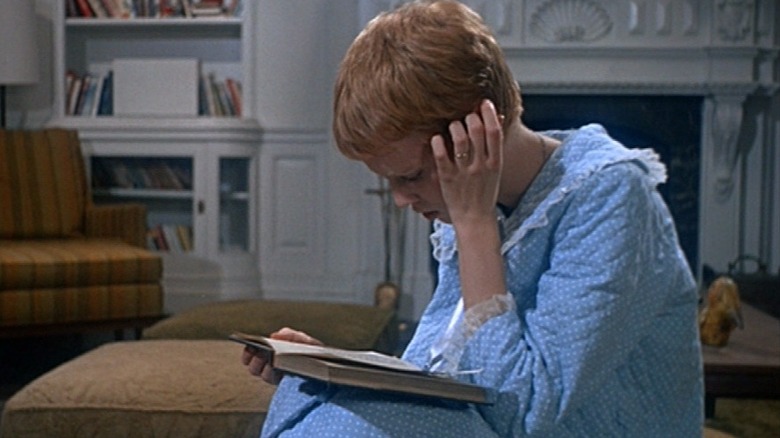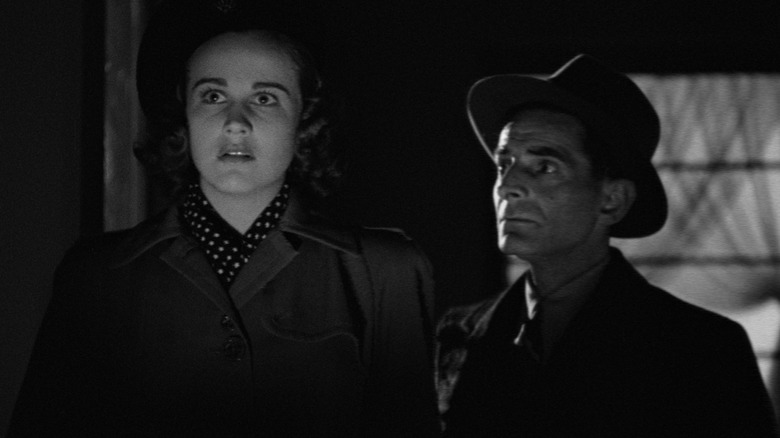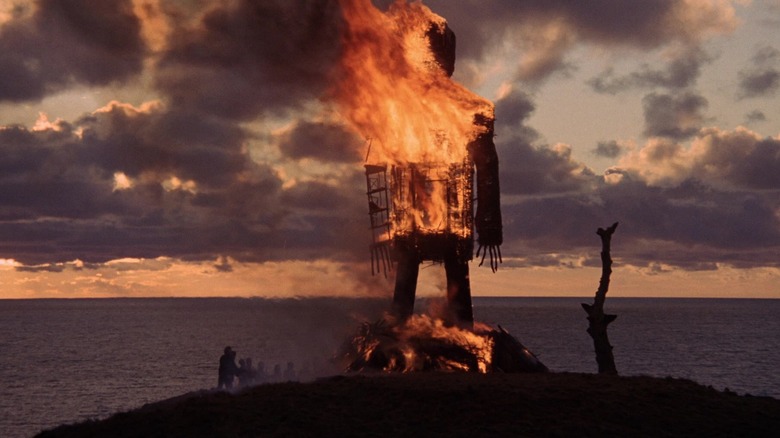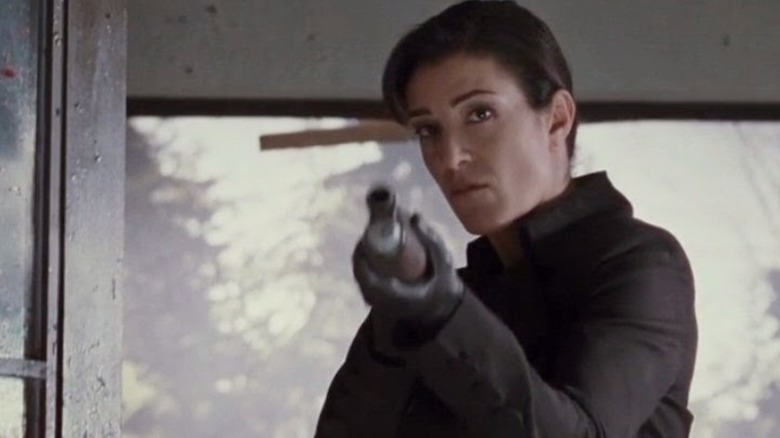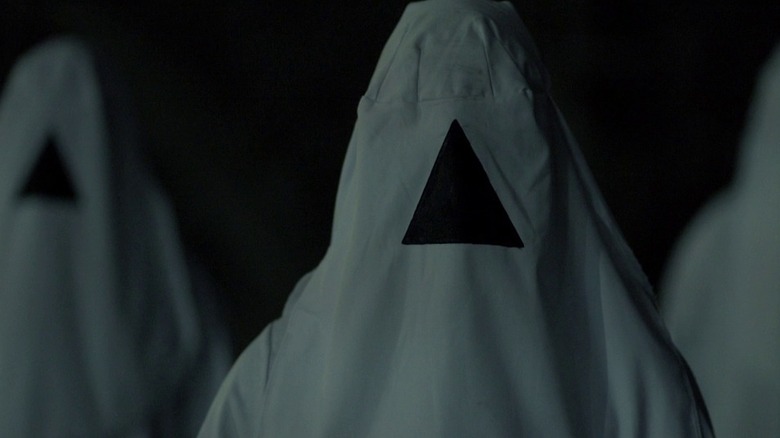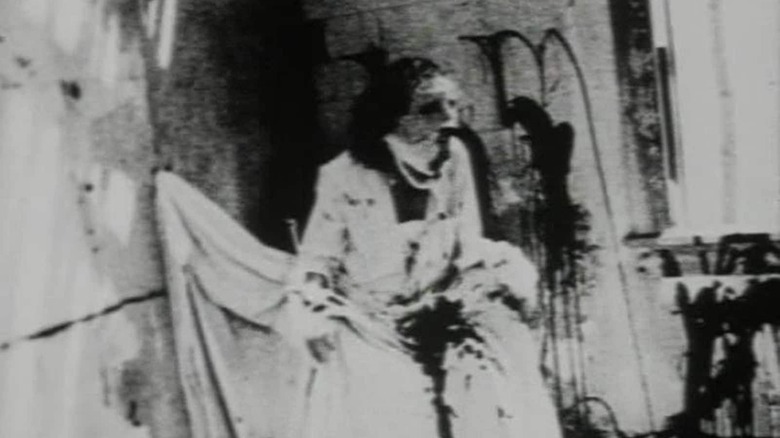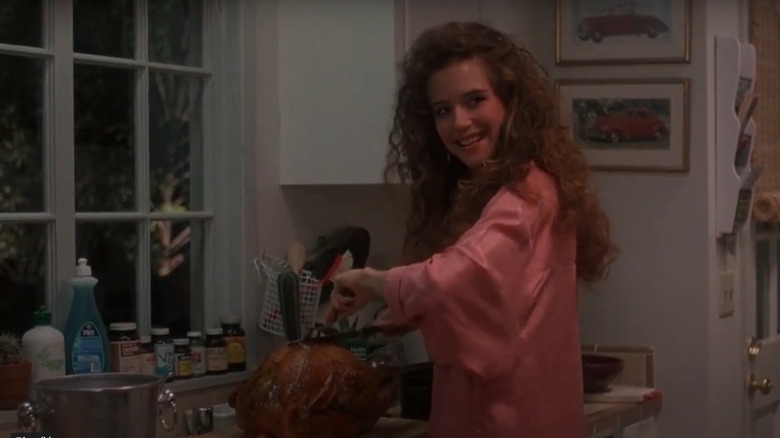The 10 Best Horror Movies About Cults
Cults are scary enough in real life. As a general rule, they infatuate your loved ones, drain their bank accounts, abuse them and make them think they like it, and in absolute worst cases — think Jonestown and Heaven's Gate — it all ends in mass death. Making that scarier for horror movies can be tough, but it usually involves actual supernatural powers. Horror movies involving cults offer them the one thing reality can't: legitimacy. In a fictional story, the dangerous demon or deity worshipped by the cultists can be real, and provably so.
Like actual cult involvement, a significant chunk of horror movies about cults end badly for their main characters. Real-world cult deprogramming takes a long time, and isn't cinematic, so in the movies, there's usually either a simpler solution, like killing the leader, or no solution at all. Satan is frequently involved, either explicitly or implicitly, in some cases offering outright evil power, and in others, pretending to be the real good guy. It turns out both versions are scary. If you prefer more realistic cult depictions, we've listed some of the best.
Most films on this list are not recent, and SPOILERS are mentioned — in some cases, it may once have been a spoiler that a cult is even involved. If you were about to watch any of these already anyway, do that before reading. If not, read on for a little extra knowledge that might push these on to your personal cult movie list.
Rosemary's Baby
"Rosemary's Baby" isn't just the best horror movie about cults. It's one of the all-time best horror movies, period, from its creepy-ass lullaby theme song to its darkly satirical big reveal that a struggling actor (John Cassavetes) would let Satan make a baby with his wife (Mia Farrow) in exchange for success. A false rumor long had it that Church of Satan leader Anton LaVey actually served as a consultant; it remained plausible for so long because the Satanists in the film behave just like your friendly neighborhood seniors, save for the one small detail that they're deliberately ushering in the Antichrist.
Director Roman Polanski keeps audiences disoriented throughout, from the unsettling rape-dream sequence to the thoroughly unclear layout of Rosemary's apartment. Polanski hasn't always had the best instincts for comedy in his career ("Pirates" is but one of many examples), but he knows suspense, expanding upon his woman-going-crazy-in-her-apartment masterpiece "Repulsion" by adding more characters and a legitimate external threat. It's also an example of great storytelling that can't really be ruined by spoilers — the movie isn't called "Rosemary's Miscarriage," after all, so we know where it's going. The fear comes with the inevitability: Rosemary, like many women not involved with Satanist cults, can't break out of her designated role however hard she may try, and the fact that her husband is part of the system keeping her down stacks the deck against her from the very beginning.
The 7th Victim
A semi-prequel to Val Lewton's original "Cat People" and the directorial debut of Lewton protegee Mark Robson ("Peyton Place"), "The 7th Victim" begins, as so many cult-based horror movies do, with a person mysteriously gone missing, in this case cosmetics entrepreneur Jacqueline Gibson (Jean Brooks). Her sister Mary ("Planet of the Apes" franchise star Kim Hunter, in her debut role) leaves her creepy, moody boarding school to head for the even creepier big city to find her, while being warned at every stage not to proceed any further in her quest. It turns out Jacqueline got mixed up with a Satanic cult who, despite professing non-violence, will exploit every loophole in their beliefs to keep themselves secret.
With its dark, shadowy film noir vibes, and a sudden shift in main-character perspective from Mary to Jacqueline for the third act, "The 7th Victim" has the Lewton aesthetic that can still be seen influencing more modern movies like "The Fog" and "The Midnight Meat Train." Its plot was thought over-confusing at the time, though in a post David Lynch world it's perfectly coherent, and even on-the-nose sometimes. Inducing fear by taking away the familiar and having characters suddenly act strangely or silently, it also manages to get away with one of the darkest endings ever in a Production Code-approved film. It's not just the fact that it ends with Jacqueline driven to suicide, but the way it's treated almost as an aside, yet one with no resolution for anybody else.
The Wicker Man
When most cinephiles think about cult-based horror, "The Wicker Man" is the movie that they have in mind. Once again following a missing persons case, it features Edward Woodward as devoutly religious Sgt. Howie, whose search begins on an island with the unimaginative name of Summerisle. The young girl isn't just nowhere to be found; nobody seems willing to even admit she ever existed. Meanwhile, Howie is shocked by how openly pagan the island is; local leader Lord Summerisle (a kilt-wearing Christopher Lee) has fully renounced Christianity, and believes he has been rewarded by prosperous crops...for the moment, at least.
As he searches further, Howie discovers evidence that the young girl, Rowan, is not just alive, but about to be sacrificed in order to bless the next harvest. He finds her and tries to save her, but the whole thing is a trap that she's been in on — Howie is in fact the sacrifice, and is burned alive inside a giant wicker man. Some dismiss the 2006 remake due to Nicolas Cage histrionics, but it holds up well too — it's easy to forget that the original has its share of campy, hippie-dippy musical numbers no less silly than Cage spitting digital bees. It's all in the service of a frivolous veneer that masks dedicated menace, like so many actual cults.
Midsommar
Ari Aster's "Midsommar" plays a bit like a modern gloss on "The Wicker Man," minus any of the aforementioned campy elements, and with a twist. In this case, protagonist Dani (Florence Pugh) is drawn to the remote cult community (this time in Sweden) with a few friends, as an attempt to escape her own grief deriving from a familial murder-suicide. Rather than eventually becoming the sacrifice, she finally presides over it, beating her trauma in the most deranged way possible. It does all end in live people burned alive inside a structure, because of course it does. (Notably, the final victim is named "Christian.")
Aster makes clear from the get-go that all is not right here, not merely because it's pagan but because, for one thing, they force all their seniors into suicide at the age of 72. Nor does he wait for the grand finale to have bad things happen to Dani's friends along the way. Dani's mind is being messed with, and her trauma somewhat gaslit, but when all is revealed, she opts in. Was the whole thing an elaborate brainwash? More disturbingly, is the movie suggesting that the only way to defeat trauma is to inflict it? You decide.
Grief and cults are recurrent themes for Aster, also serving as the subject of his "Hereditary." Though ultimately about a demon cult, it's best remembered for a decapitation scene that will forever warn viewers to not stick their heads out car windows.
Martyrs
Clive Barker's "Hellraiser" franchise hinted at linking religion to sado-masochism, by stating that his extra-dimensional Cenobites were angels to some, and demons to others. They preyed on curious individuals, however, while Pascal Laugier's "Martyrs" pushes the notion further. Why wouldn't a cult arise that sought transcendence from extreme mutilation, if indeed such experiences are the most extreme that a human being can experience? There is a catch, of course — the cult don't torture and flay themselves, but rather kidnapped women, from whom they hope to extract the secrets of life and death.
One does not simply walk into "Martyrs" as a casual horror fan. It's the kind of film that really pushes the limits of what an ordinary viewer can take, one that even many horror fans can hardly finish, and it offers no satisfaction that things will be set right. The Weinstein Company bought U.S. distribution rights before opting not to release it, while France initially gave it the 18+ rating reserved for pornography before all the French film industry unions pushed back, out of national pride.
Eight years later, an American remake faced no such obstacles and was released by Anchor Bay. Since it's mostly only been watched by fans of the original, the remake has been disproportionately badmouthed. It's not terrible in and of itself if you're allergic to subtitles and want slightly less gore...just mostly redundant if you've seen its source material.
The Void
H.P. Lovecraft has had an outsized influence on horror filmmakers of today, many of whom are infatuated with his monstrous elder gods, deranged cults, and sights to drive men mad. (Check out our list of the 22 best Lovecraftian movies of all time.) Generally, though, the movies that have drawn most inspiration from his work (think "From Beyond") focus more on the monsters and madness than the cults. "The Void," however, has it all: dark dimensions, deadly cultists, transformative body horror, monsters, and madness. Set in a mostly empty hospital — via plot and location conveniences — it's a night of survival terror with far more creative antagonists than the usual zombies or homogeneous hordes. It's also the best '80s horror throwback in years.
Before "Squid Game" spooked us with its symbol-masked guards, "The Void" offered up triangle-hooded cultists, for whom the three sides may or may not represent an unholy trinity. Kenneth Welsh (Windom Earl on "Twin Peaks") is the most familiar face in a mostly unknown cast; codirector Jeremy Gillespie was inspired by overhearing Guillermo del Toro as he worked on the ultimately unmade Lovecraft adaptation "At the Mountains of Madness."
Frustratingly, the movie ends with teases of a much larger mythology that would never be explored further, but that doesn't negate the joys of the creature effects and spooky vibes that permeate this chunk of pure eldritch delight throughout.
Begotten
Very few movies can be called pure nightmare fuel like "Begotten" can. With only the most tenuous of narratives, and footage that looks like it's been aged, battered, and overexposed, its barely seen disturbing images come without dialogue or explanation. All that can be gathered comes from character names revealed in the end credits.
In a house in the woods, a being (billed as God Killing Himself) who looks like Leatherface in a wedding dress slowly and methodically cuts himself open with a straight razor. A female figure in a masquerade mask (Mother Earth) emerges from beneath him as he dies, impregnating herself with his seed. She gives birth to Son of Earth — Flesh on Bone, a twitching adult, whom she leaves in the dirt. He is taken by a robed cult, who tie him to a cliff, force-feed him his own entrails, and then appear to both wash and burn him alive. He's reborn, but taken by another cult in wicker-ish outfits, who abuse both him and his mother.
Maybe that's not exactly what happens. With murky visuals and no clear story, it's hard to tell. The effect is one of sights never meant to be seen, on film that may have been long-buried before exposure. In fact, director E. Elias Merhige originally meant it to be an experimental live dance theater piece, though as such, the inherent suspension of disbelief a theater provides would have made the imagery easier on the soul.
Mandy
If you've seen the images of Nicolas Cage covered in blood, you might be led to expect a certain kind of movie, which "Mandy" both is and isn't. For much of the runtime, Cage keeps his acting real, or rather as real as it can be when we're dealing with a cult who might just be existing in a completely different dimension from our own. Director Panos Cosmatos generally sets his own rules of how things work, and seemingly inspired by '80s heavy metal album and horror novel covers, he creates an immersive nightmare that slowly consumes the woods in which Red (Cage) and Mandy (Andrea Riseborough) live, until cult leader Jeremiah Sand (Linus Roache) decides he wants Mandy for his own, so he send some Clive Barker-esque creatures to kidnap her, then has her burned to death when she doesn't respond to his advances.
Eventually, yes, you get Cage fighting with a chainsaw and a mighty battle ax, although he notably avoids fighting a tiger that briefly shows up. The cult does not prevail in this film.
Though it's far from the only film in which Cage fights dark forces — "Willy's Wonderland" is another fun one — "Mandy" struck a box-office nerve (despite a limited theatrical release) thanks to Cosmatos' deliberately lo-fi universe-building, and his willingness to let Cage play low-key emotional scenes in addition to the craziness. The movie also contains an utterly grotesque commercial for the fictional Cheddar Goblin macaroni and cheese that's as nauseating as any of the violence.
The Sacrament
What if the Jonestown Massacre happened in the present day, and Vice media were there to document it? That's the premise of Ti West's 2013 found-footage horror tale, with the cameraman POV frequently lending it the feel of a first-person video game. Mumblecore auteur Joe Swanberg stars as Jake the cameraman, occasionally shooting some of the footage himself; A.J. Bowen, of "The House of the Devil," plays his journalistic partner and on-camera host Sam.
Sensing a suitable story in their coworker's tale of his sister suddenly resurfacing in an overseas cult commune of some kind, they tag along with him. Initially, what they find is a friendly place where everyone lives in harmony with the land, and even though cult leader "Father" (Gene Jones) has the manner of a Southern-style televangelist, he turns out to be ostensibly a left-winger who opposes racism and imperialism.
"The Sacrament" keeps you guessing for a while just how everything that seems so nice will inevitably turn awful, and at first, the intrusion of a scary-faced mute girl seems a little obvious. Once we know her story, however, all hell and Kool-Aid breaks out. Some might debate whether this counts as a horror movie, given that the cult is non-supernatural, but some gory set pieces towards the very end cannot truly be called anything but. West typically favors small locations and slow-burns, so the compound makes his most epic canvas yet.
Spellbinder
Cult expert Chris Shelton considers "Spellbinder" one of his all-time favorite movies about cults, and it's easy to see why: glorious with '80s excess and grit, it is to horror movies what something like "Lethal Weapon" is to action. (At one point, the characters drive by a billboard for "Willow" on the Sunset Strip.) A pre-stardom Tim Daly and Kelly Preston star as Jeff and Miranda: he's a young lawyer fresh off of a basketball game; she's the seeming victim of domestic violence in a public setting. He saves her, or so he thinks, she lays hands on him to heal his back pain, and they have explicit sex. Before long, though, the cult she's been part of wants her back, and they're willing to magically set people's heads on fire in order to get her.
Though the heightened sex and violence, big shoulders, synth score (by the awesome Basil Poledouris), and hairspray give "Spellbinder" more than a touch of period cheese, its use of real locations and occasional handheld footage gives it a real sense of urban danger too. A young Cary-Hiroyuki Tagawa costars in a rare nonvillain role as one of the few honest cops in town, while M.C. Gainey entertains as a right-wing survivalist whose protective arsenal ultimately proves less robust than he thinks.
"Spellbinder" feels like it ought to have been a big hit in 1988, but it wasn't, given a very limited release by MGM. As a time capsule, however, it's totally tubular.

